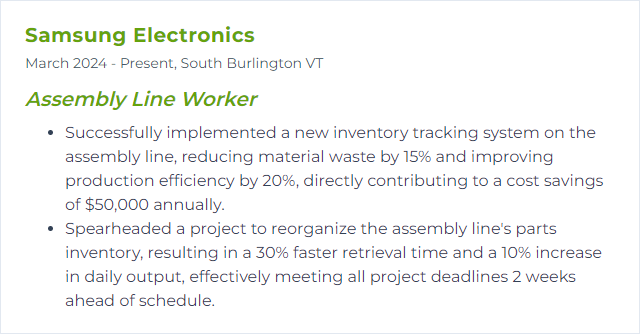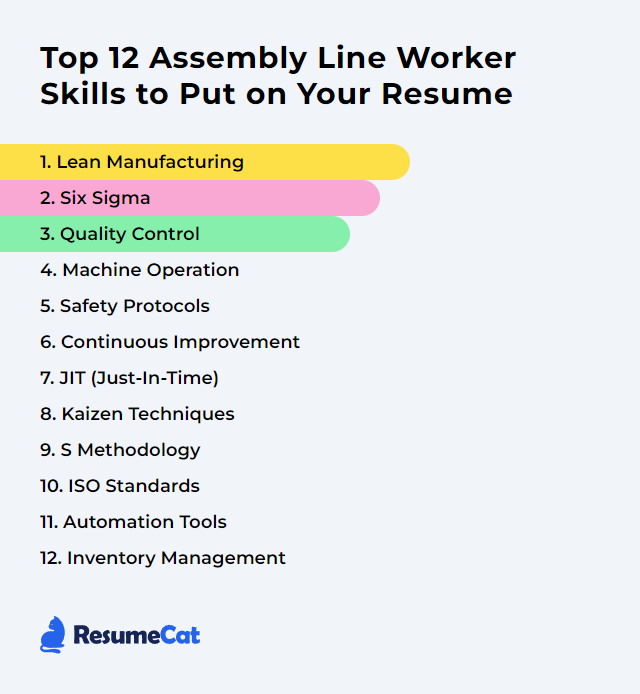Top 12 Assembly Line Worker Skills to Put on Your Resume
Manufacturing moves fast. Assembly line workers keep that rhythm alive, turning parts into finished products with precision and pace. The right skills on a resume don’t just look good—they signal reliability, speed, and safety. Below, the essentials that help you get noticed and hired.
Assembly Line Worker Skills
- Lean Manufacturing
- Six Sigma
- Quality Control
- Machine Operation
- Safety Protocols
- Continuous Improvement
- JIT (Just-In-Time)
- Kaizen Techniques
- 5S Methodology
- ISO Standards
- Automation Tools
- Inventory Management
1. Lean Manufacturing
Lean Manufacturing trims waste and sharpens flow. It’s about delivering more value with fewer headaches—cleaner processes, fewer delays, smoother output.
Why It's Important
Lean makes the line faster, safer, and steadier. Less scrap, fewer stoppages, better quality. That means stronger numbers and calmer days.
How to Improve Lean Manufacturing Skills
Make small changes that stick. Keep things visual, simple, and repeatable.
- Practice Kaizen: Spot tiny friction points and remove them. Every shift.
- Apply 5S: Sort, Set in order, Shine, Standardize, Sustain. A tidy line moves like clockwork.
- Use Kanban/JIT signals: Pull work when needed, not “just in case.”
- Standardize work: Clear steps, clear timing, clear outputs.
- Empower the floor: Frontline ideas beat boardroom guesses.
- Visual management: Boards, labels, andons—make status obvious at a glance.
- Root cause first: 5 Whys or fishbone diagrams to fix the real issue, not the symptom.
Keep it tight, keep it flowing. That’s lean in action.
How to Display Lean Manufacturing Skills on Your Resume

2. Six Sigma
Six Sigma is a data-driven method to cut defects and variation. DMAIC—Define, Measure, Analyze, Improve, Control—turns problems into disciplined improvements.
Why It's Important
Fewer mistakes, more consistency. Customers notice. So does your supervisor.
How to Improve Six Sigma Skills
- Know DMAIC: Use the steps, don’t skip them.
- Measure accurately: Good data or it’s guesswork.
- Apply basic statistics: Pareto, histograms, control charts—simple tools, big gains.
- Poka‑yoke: Design steps to make errors hard to make and easy to see.
- Collaborate: Share findings, test countermeasures, lock in wins.
- Sustain changes: Standardize, audit, review. Keep drift at bay.
How to Display Six Sigma Skills on Your Resume

3. Quality Control
Quality Control means checking parts and products against standards at the right steps—catching issues early, not after the fact.
Why It's Important
It protects the customer, the brand, and the line’s rhythm. Fewer reworks. Less waste. Stronger trust.
How to Improve Quality Control Skills
- Follow SOPs: Consistency beats improvisation.
- Use checklists and gauges: Make pass/fail clear and quick.
- Apply QC tools: Pareto, check sheets, sampling plans.
- First-article checks: Verify setups before running volume.
- Close the loop: Report defects, share patterns, propose fixes.
- Preventive maintenance: Healthy machines make good parts.
How to Display Quality Control Skills on Your Resume

4. Machine Operation
Machine operation covers setup, safe use, changeovers, and basic troubleshooting. You keep equipment productive and predictable.
Why It's Important
No uptime, no output. Skilled operators protect quality and schedule.
How to Improve Machine Operation Skills
- Train deeply: Learn controls, limits, alarms, and safety interlocks.
- Master changeovers: Cut setup time with organized tools and clear steps.
- Watch the parameters: Temperature, speed, pressure—tune within spec.
- Do daily checks: Lubrication, wear points, alignment, sensors.
- Log issues: Document faults, fixes, and patterns to speed future solves.
How to Display Machine Operation Skills on Your Resume
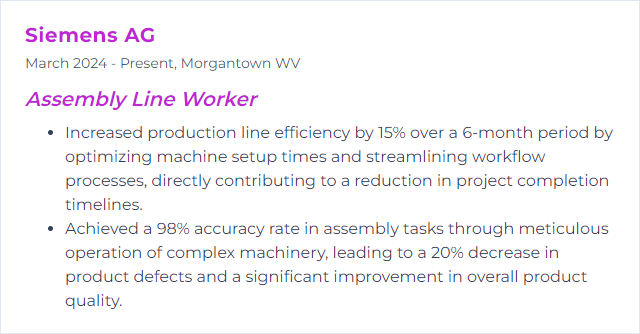
5. Safety Protocols
Safety protocols are the guardrails: PPE, lockout/tagout, clear procedures, clean floors, smart ergonomics, crisp emergency actions.
Why It's Important
Safe work is steady work. Fewer injuries, fewer stops, better morale.
How to Improve Safety Protocols Skills
- Refresh training: Short, frequent, task-specific.
- Run hazard assessments: Identify pinch points, sharp edges, high-heat zones.
- Use the right PPE: And replace it when worn.
- Prioritize ergonomics: Adjust height, reach, and posture; rotate when needed.
- Report near misses: Early warnings prevent real accidents.
- Maintain equipment: Guards in place, e-stops tested, tools intact.
- Drill emergencies: Exits clear, roles known, response fast.
How to Display Safety Protocols Skills on Your Resume
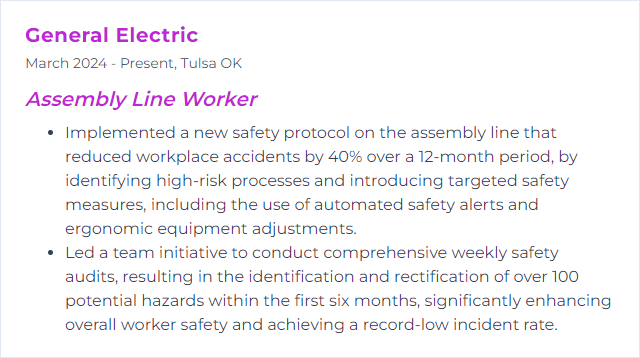
6. Continuous Improvement
Continuous improvement is the habit of making today’s job slightly better than yesterday’s. Small wins, compounded.
Why It's Important
It reduces waste, eases strain, and boosts quality. Over time, it transforms a line.
How to Improve Continuous Improvement Skills
- Run PDCA cycles: Plan, do, check, adjust—quickly and often.
- Visualize metrics: Takt time, defects, downtime—post and review.
- Share ideas: Bring one improvement to every team huddle.
- Test small: Pilot changes on a single station before scaling.
- Map flow: Value-stream snapshots expose delays and handoff pain.
How to Display Continuous Improvement Skills on Your Resume
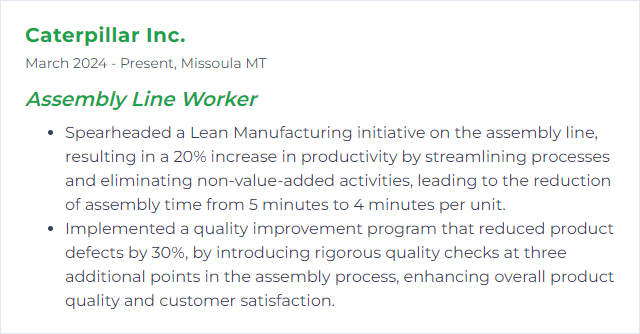
7. JIT (Just-In-Time)
JIT delivers parts and builds product when needed—no big stockpiles, no stale inventory. Flow instead of buffer.
Why It's Important
Lower costs, fewer touches, faster response. Problems surface sooner, where they can be fixed.
How to Improve JIT (Just-In-Time) Skills
- Balance to takt time: Match station pace to customer demand.
- Cross-train: Flex to cover bottlenecks and absences.
- Use kanban: Simple signals to pull materials right on time.
- Speed changeovers: Quick setups keep batches small and flow steady.
- Quality at the source: Stop defects immediately; don’t pass them on.
- Align with suppliers: Clear schedules, reliable deliveries, tight feedback.
How to Display JIT (Just-In-Time) Skills on Your Resume
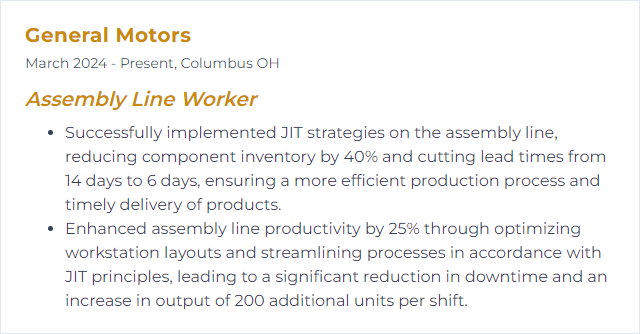
8. Kaizen Techniques
Kaizen means steady, everyday improvement. Workers closest to the work suggest changes, test them, and keep what works.
Why It's Important
It builds ownership and momentum. Small tweaks clear chronic headaches.
How to Improve Kaizen Techniques Skills
- Standardize first: Stability before improvement.
- Run 5S: Clear spaces reveal clear problems.
- Use visual cues: Lines, labels, boards—make abnormalities pop.
- Team problem-solving: Short sessions, tight scopes, documented actions.
- Root cause focus: 5 Whys to get past the surface.
- Capture wins: Update standards so gains don’t fade.
How to Display Kaizen Techniques Skills on Your Resume

9. 5S Methodology
5S—Sort, Set in order, Shine, Standardize, Sustain—organizes work so motion is smooth and mistakes stand out.
Why It's Important
Less clutter, quicker grabs, safer moves. You slash search time and keep tools ready.
How to Improve 5S Methodology Skills
- Sort: Remove rarely used items; red‑tag the maybes.
- Set in order: Label, shadow-board, color-code. A place for everything.
- Shine: Clean while inspecting; cleaning finds wear.
- Standardize: Visual standards, checklists, schedules.
- Sustain: Audits, coaching, and daily habits so 5S sticks.
How to Display 5S Methodology Skills on Your Resume
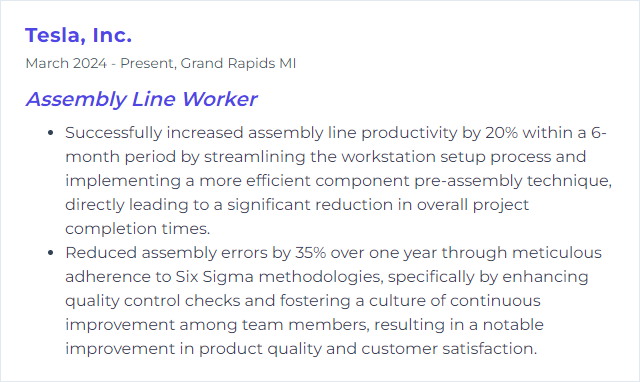
10. ISO Standards
ISO Standards set common rules for quality, safety, and consistency. On the line, they translate into clear procedures, records, and checks.
Why It's Important
They keep results predictable and compliant. Less rework, fewer surprises during audits.
How to Improve ISO Standards Skills
- Know what applies: Quality (ISO 9001), health and safety (ISO 45001), and related procedures.
- Follow the process: Use the latest work instructions every time.
- Document properly: Accurate records, traceability, and sign-offs.
- Internal audits: Prepare, participate, and act on findings.
- CAPA discipline: Corrective and preventive actions that actually prevent repeats.
- Calibration and care: Tools and gauges verified on schedule.
How to Display ISO Standards Skills on Your Resume

11. Automation Tools
Automation tools include robots, conveyors, HMIs, sensors, and the software that coordinates them. They amplify precision and pace.
Why It's Important
Better throughput, consistent quality, lighter strain on people. Fewer manual errors.
How to Improve Automation Tools Skills
- Learn the interface: HMI screens, modes, alarms, and safe starts.
- Basic robot know-how: Teach points safely, run routines, recover from faults.
- Read the data: Dashboards, counters, cycle times—spot drift early.
- Standard recoveries: Clear steps to unjam and restart without damage.
- Update skills: New firmware, new features—stay current.
- Safety first: Light curtains, interlocks, LOTO—never bypass protections.
How to Display Automation Tools Skills on Your Resume
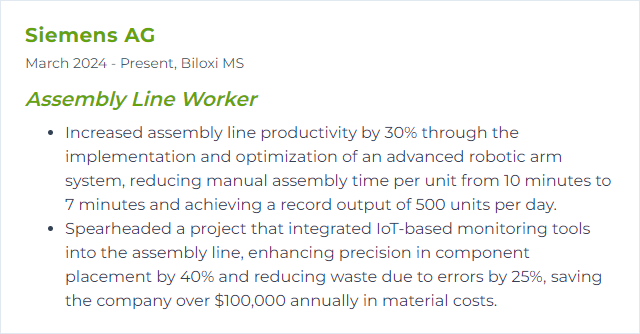
12. Inventory Management
Inventory management ensures the right parts arrive at the right station at the right moment. No starved lines. No overstuffed bins.
Why It's Important
Downtime falls when materials are on time. Costs fall when excess stock disappears.
How to Improve Inventory Management Skills
- Use kanban or reorder points: Simple signals keep flow steady.
- Cycle count routinely: Catch errors before they snowball.
- FIFO/FEFO discipline: Oldest parts first, no aging surprises.
- Label and zone clearly: Parts, quantities, locations—no hunting.
- Communicate shortages fast: Escalate early to protect the schedule.
How to Display Inventory Management Skills on Your Resume
